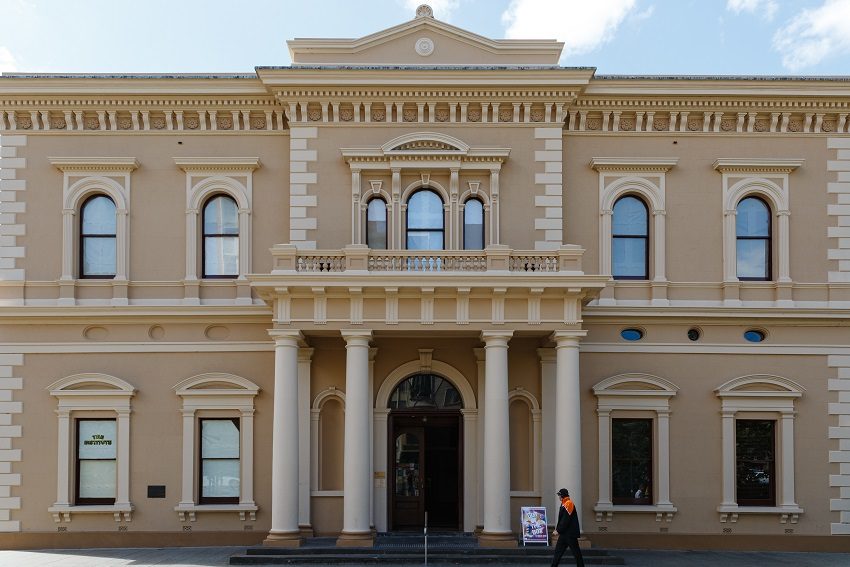160 Years and Proud of it at Royal South Australian Society of Arts

Turning 160 is proof of something. Sustainability for one thing. Adelaide art historian Adam Dutkiewicz has compiled and edited a book to mark this commemoration, a history of the Royal South Australian Society of Arts (RSASA), 1856–2016.
This is a very impressive piece of research which assembles all the various bits of jig-saw that were previously scattered throughout the society’s reports, minutes, its newsletter Kalori, news cuttings and catalogues. The added bonus is that the book includes biographical outlines and images of work by well known but also less familiar figures who have been closely associated with the society since its foundation.
The book will be pored over and treasured everyone who has been associated with the society – as it should. But for the wider art community there are significant narratives that define the society’s important role in operating as a prominent exhibition space for decades when decent exhibition spaces were in short supply and encouraging community interest in the visual arts through exhibitions and lecture series. A companion volume to this 400 page glossy is scheduled for 2017.

Proud to be 160 showcases works by significant artists over these years, from the Art Gallery of SA, RSASA Collection and past and current members. Pats on the back all round no doubt. But the occasion hopefully doesn’t slip by in a welter of self congratulations without some reflection on the path travelled and anticipated.
There were good reasons for the schism that occurred in 1942, which saw a group of RSASA Associates forming a South Australian Branch of the Contemporary Art Society. The group’s First Exposition catalogue contained a number of spirited statements claiming among other things that South Australian art was a “dummy art founded on imitation of the past”.
But by the late 1940s, some of the heat had gone out of the argument that the RSASA was incapable of moving with the times. Ivor Francis, for example, expressed the hope at the time that the complementary nature of the two societies would come to be appreciated. It is worth noting that the CASSA maintained relations with its parent body, sharing much of its membership, and continued to exhibit annually at the RSASA Gallery until 1964 when it secured its own premises at Porter Street Parkside.

Clifton Pugh, Cat in a Rabbit Trap, c1976, oil on board, RSASA Collection. Acquisitive Caltex Prize. early 1970s
Today, it appears no longer relevant to talk about the RSASA and Contemporary Art Centre of SA (CACSA) as having any kind of complementary relationship in a sense of really needing each other. These two organisations march to their own drums. And with CACSA now committed to working with the Australian Experimental Art Foundation (AEAF) to develop a new contemporary art entity in Adelaide the prospect of RSASA being invited, or willing, to come to the party appear remote. But never say never.
That RSASA is conscious of its need to involve younger generations of artists is evident in a number of programmes such as Youthscape and the biannual Portrait Prize which attracts a wide field of entrants and styles. Current Director Bev Bills foresees a need to “embrace new art techniques” that “hopefully will include a hint of historical balance.” For Bills, and I suspect many other members, the imperative to continue to create, to make art, by whatever means and expressions, matters above all.

The issue at hand is how do you take studio traditions on into the future in an authentic way and build that next generation of membership without lapsing into isolationism or kidding yourself that it’s all about getting some ’young people’ on board. At present, here in Adelaide, most ‘young people’ of ambition and talent are shooting out the lights by sourcing their own gallery spaces, self-marketing aggressively, travelling widely, networking furiously, working collaboratively and taking big risks in exploring conceptual and technical possibilities.
Perhaps within the RSASA there is the will to have a conversation or an alignment with this trajectory rather than stick to a mindset that holds that most contemporary art is sensational, all style and no substance and its just a matter of waiting for young artists to come to their senses and appreciate the value of time-honoured traditions. If there is such a will RSASA can come to the trading table with its centrally located gallery space and deal from there.
Creative partnerships with artist collectives and sponsorships of more speculative forms of art practice – these can all be on the table – including ongoing debate about and celebrations of the studio tradition’s legacies. A dash of Dao wouldn’t hurt. Duality doesn’t have to signify competition or separation. Opposites can complement and provide each other with meaning. Happy birthday.
Proud to be 160, Royal South Australian Society of Arts
RSASA Gallery, Level 1, Institute Building, North Tce
Until Sunday, December 4
rsasarts.com.au